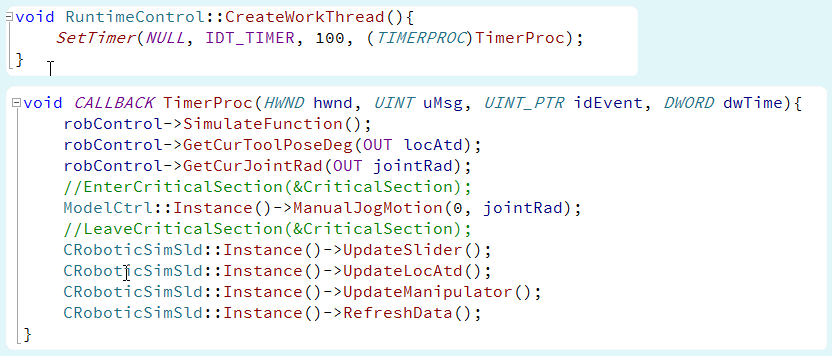MFC程序中有
但是在控制台应用程序中没有,以下为实现的几种方式,第二种比较常见。
原文来自:https://blog.csdn.net/jiangqin115/article/details/47981159
1.SetTimer:在控制台应用程序中同样可以用SetTimer实现定时器的效果。
普通的win32程序中定时器的应用很多也很方便,但是在win32控制台中也是可以使用定时器的,利用的是windows程序的消息循环机制,如下:
#include<iostream>
#include<windows.h>
using namespace std;
//定时器ID
DWORD dwTimerId = 0;
void CALLBACK TimeProc( HWND hwnd, UINT message, UINT idTimer, DWORD dwTime)
{
if (dwTimerId == idEvent)
{
cout<<"触发定时器!"<<endl;
}
}
int main()
{
//必须用消息循环,否则Timer无效
//返回值位定时器ID,而不是参数1
dwTimerId = SetTimer(NULL,1,1000,TimeProc);
MSG msg;
while(GetMessage(&msg,NULL,0,0))
{
if(msg.message==WM_TIMER)
{
DispatchMessage(&msg);
}
}
return 0;
}
2. 线程+SetTimer:网上牛人用线程做的相同效果
#include <windows.h>
#include <stdio.h>
#include <conio.h>
int count =0;
DWROD dwTimerId = 0;
VOID CALLBACK TimerProc(HWND hwnd,UINT uMsg, UINT_PTR idEvent, DWORD dwTime)
{
if (dwTimerId == idEvent)
{
count++;
printf("WM_TIMER in work thread count=%d\n",count);
}
}
DWORD CALLBACK Thread(PVOID pvoid)
{
MSG msg;
PeekMessage(&msg,NULL,WM_USER,WM_USER,PM_NOREMOVE);
dwTimerId = SetTimer(NULL,111,1000,TimerProc);
BOOL bRet;
while ((bRet = GetMessage(&msg,NULL,0,0)) != 0)
{
if(bRet == -1)
{
//handle the error and possibly exit
}
else
{
TranslateMessage(&msg);
DispatchMessage(&msg);
}
}
KillTimer(NULL,timerid);
printf("thread end here\n");
return 0;
}
int main()
{
DWORD dwThreadId = 0;
printf("use timer in workthread of console application\n");
HANDLE hThread = CreateThread(NULL,0,Thread,0,0,&dwThreadId);
getch();
return 0;
} 3. timeSetEvent -- Windows多媒体高精度定时器
函数:MMRESULT timeSetEvent(UINT uDelay, UINT uResolution, LPTIMECALLBACK lpTimeProc, WORD dwUser, UINT fuEvent)
说明:
uDelay:以毫秒指定事件的周期。
Uresolution:以毫秒指定延时的精度,数值越小定时器事件分辨率越高。缺省值为1ms。
LpTimeProc:指向一个回调函数。
DwUser:存放用户提供的回调数据。
FuEvent:指定定时器事件类型:
TIME_ONESHOT:uDelay毫秒后只产生一次事件
TIME_PERIODIC :每隔uDelay毫秒周期性地产生事件。
#include<iostream>
#include<windows.h>
#include <Mmsystem.h>
#pragma comment(lib, "winmm.lib")
using namespace std;
void CALLBACK TimeProc(UINT uID,UINT uMsg,DWORD dwUser,DWORD dw1,DWORD dw2)
{
cout<<"定时器触发!"<<endl;
}
int main()
{
timeSetEvent( 1000,0, TimeProc, 0, (UINT)TIME_PERIODIC);
getchar();
} 此外,改写为一个类中的例子
/************************************************************************/
/* */
/************************************************************************/
class CTimer
{
public:
CTimer();
void CreateTimerThread(int* pi);
static DWORD CALLBACK TimeThread(PVOID pvoid);
static void CALLBACK TimeProc(HWND hWnd, UINT uMsg, UINT_PTR idEvent, DWORD dwTime);
};
CTimer::CTimer()
{}
void CTimer::CreateTimerThread(int* pi)
{
HANDLE hand = CreateThread(NULL, 0, CTimer::TimeThread, pi, 0, NULL);
}
DWORD CALLBACK CTimer::TimeThread(PVOID pvoid)
{
int* pi = (int*)pvoid;
int itm = *pi;
MSG msg;
PeekMessage(&msg, NULL, WM_USER, WM_USER, PM_NOREMOVE);
UINT timeid = SetTimer(NULL, 111, itm, CTimer::TimeProc);
BOOL bRet;
while ((bRet = GetMessage(&msg, NULL, 0, 0)) != 0)
{
if (bRet == -1)
{
printf("Error:the thread will quit,error id is %d\n", GetLastError());
break;
} else
{
TranslateMessage(&msg);
DispatchMessage(&msg);
}
}
KillTimer(NULL, timeid);
printf("thread end here/n");
return 0;
}
void CALLBACK CTimer::TimeProc(HWND hWnd, UINT uMsg, UINT_PTR idEvent, DWORD dwTime)
{
printf("WM_TIMER in work thread count\n");
}
int main()
{
int iTime = 500;
int* pi = &iTime;
CTimer* ptime = new CTimer;
ptime->CreateTimerThread(pi);
//_getch();
while (true)
{
cout << "Main~~" << endl;
}
return 0;
};https://www.cnblogs.com/fripside/archive/2013/02/12/2910240.html 在这篇帖子中提到建议使用更安全的_beginthreadex
HANDLE hSendThread = (HANDLE)_beginthreadex(NULL, 0, SendThread, NULL, 0, NULL);
unsigned int __stdcall SendThread(PVOID pM)
{
MSG msg;
PeekMessage(&msg, NULL, WM_USER, WM_USER, PM_NOREMOVE);
unsigned long dwTimerId = 0;
dwTimerId = SetTimer(NULL, 111, 100, (TIMERPROC)SendProc);
//dwTimerId = SetTimer(NULL, 111, 100, (TIMERPROC)TimerProc_print);
BOOL bRet;
while ((bRet = GetMessage(&msg, NULL, 0, 0)) != 0)
{
if (bRet == -1)
{
//handle the error and possibly exit
std::cout << "Thread error" << endl;
return -1;
} else
{
TranslateMessage(&msg);
DispatchMessage(&msg);
}
}
KillTimer(NULL, dwTimerId);
printf("thread end here\n");
return 0;
}
void CALLBACK SendProc(UINT uID, UINT uMsg, DWORD dwUser, DWORD dw1, DWORD dw2) // mm_timer
{
std::cout << "send proc" << endl;
static int(*MyInitAPI)();
static int(*MyCloseAPI)();
static int(*MyGetDevices)(KinovaDevice devices[MAX_KINOVA_DEVICE], int &result);
static int(*MySetActiveDevice)(KinovaDevice device);
static int(*MySendBasicTrajectory)(TrajectoryPoint command);
MyInitAPI = (int(*)()) GetProcAddress(hcommandLayer_send_thread, "InitAPI");
MyCloseAPI = (int(*)()) GetProcAddress(hcommandLayer_send_thread, "CloseAPI");
MyGetDevices = (int(*)(KinovaDevice devices[MAX_KINOVA_DEVICE], int &result)) GetProcAddress(hcommandLayer_send_thread, "GetDevices");
MySetActiveDevice = (int(*)(KinovaDevice devices)) GetProcAddress(hcommandLayer_send_thread, "SetActiveDevice");
MySendBasicTrajectory = (int(*)(TrajectoryPoint)) GetProcAddress(hcommandLayer_send_thread, "SendBasicTrajectory");
//========================== Joint V control =====================================
static int result = 0;
(*MyInitAPI)();
KinovaDevice list[MAX_KINOVA_DEVICE];
int devicesCount = MyGetDevices(list, result);
MySetActiveDevice(list[0]);
TrajectoryPoint pointToSend;
pointToSend.InitStruct();
//We specify that this point will be used an angular(joint by joint) velocity vector.
pointToSend.Position.Type = CARTESIAN_VELOCITY;
pointToSend.Position.CartesianPosition.X = 0;
pointToSend.Position.CartesianPosition.Y = 0.15f; // m/s
//pointToSend.Position.CartesianPosition.Y = Kp*Ey; // m/s
pointToSend.Position.CartesianPosition.Z = 0;
pointToSend.Position.CartesianPosition.ThetaX = 0;
pointToSend.Position.CartesianPosition.ThetaY = 0;
pointToSend.Position.CartesianPosition.ThetaZ = 0.0;// rad/s
pointToSend.Position.Fingers.Finger1 = 0;
pointToSend.Position.Fingers.Finger2 = 0;
pointToSend.Position.Fingers.Finger3 = 0;
MySendBasicTrajectory(pointToSend);
Sleep(5);
MyCloseAPI();
}CloseHandle(hSendThread);
关于结束线程
http://www.xuebuyuan.com/349166.html
https://blog.csdn.net/q_l_s/article/details/52625020
